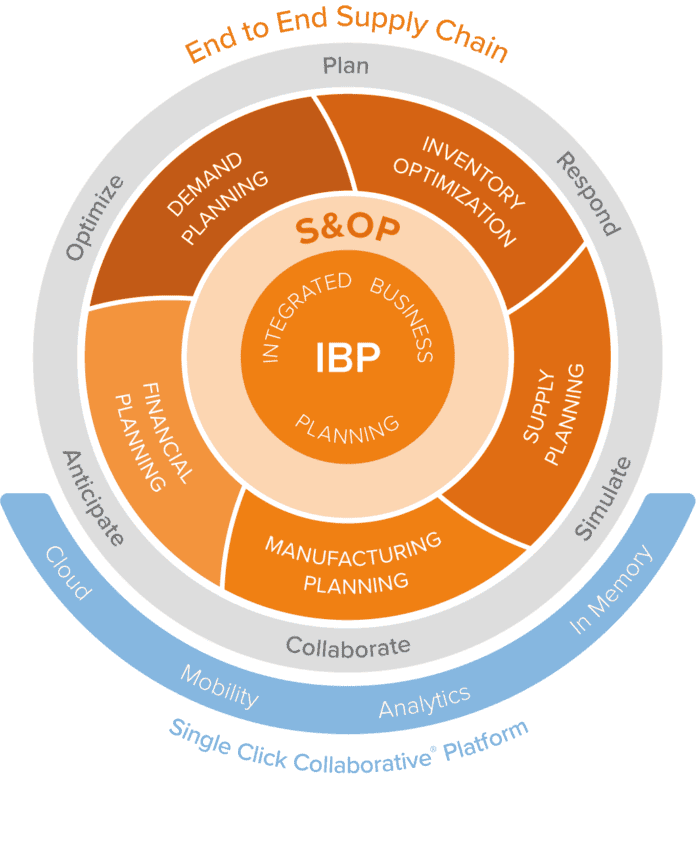Integrated Business Planning (IBP) plays a defining role in the overall growth of the business. In the dynamic business landscape companies are looking for solutions that can seal the gap between various business functions that drive efficiency and agility.
Since the supply chain plays an integral role in the growth of the business, IBP or Integrated business planning in the supply chain becomes crucial.
In this blog, we will delve into the intricacies of Integrated Business Planning, exploring its role in the supply chain, providing examples, understanding its implementation in SAP, exploring the framework, and deciphering the crucial processes and execution strategies.
Integrated Business Planning in the Supply Chain
Integrated Business Planning is a strategic approach that integrates various business functions to streamline decision-making processes across an organization. In the context of the supply chain, IBP aims to align demand, supply, and finance functions, breaking down silos and fostering collaboration. By providing a holistic view of the entire supply chain, organizations can enhance their responsiveness to market changes, minimize risks, and optimize resource utilization.
Key Components of Integrated Business Planning
Demand Planning
At the core of Integrated Business Planning is demand planning. This component involves forecasting future demand based on historical data, market trends, and other relevant factors. By aligning demand projections with overall business objectives, organizations can optimize inventory levels and ensure a responsive supply chain.
Inventory Management
Another integral component of IBP is inventory management. This entails overseeing the entire inventory lifecycle, from procurement to storage and distribution. By integrating inventory management into the planning process, organizations can prevent stockouts, minimize holding costs, and enhance overall supply chain efficiency.
Financial Planning
Financial planning forms the financial backbone of Integrated Business Planning. This component involves aligning the budgeting and financial forecasting processes with operational plans. By integrating financial considerations into the overall planning framework, organizations can ensure that strategic decisions are financially viable and contribute to the bottom line.
Sales and Operations Planning (S&OP)
Sales and Operations Planning is the bridge that connects demand planning, inventory management, and financial planning. It involves a collaborative process where cross-functional teams work together to align sales forecasts with operational plans. S&OP ensures that all departments are on the same page, fostering coordination and minimizing conflicts.
Collaboration and Communication
While not a traditional “component,” effective collaboration and communication are intrinsic to successful Integrated Business Planning. This involves breaking down silos between departments, fostering transparency, and ensuring that information flows seamlessly across the organization. Clear communication enhances the effectiveness of the planning process.
Technology Integration
In the digital age, technology plays a pivotal role in the key components of IBP. Advanced analytics, artificial intelligence, and collaborative platforms empower organizations to make data-driven decisions. Technology integration ensures that the planning process is not only efficient but also adaptable to the dynamic nature of modern business.
Risk Management
A proactive approach to risk management is a crucial component of IBP. This involves identifying potential risks, assessing their impact on operations, and developing strategies to mitigate these risks. By incorporating risk management into the planning process, organizations can navigate uncertainties with resilience.
Scenario Planning
Scenario planning involves considering various possible future scenarios and developing strategies to address each scenario. This forward-thinking approach allows organizations to be agile in the face of changing market conditions. Scenario planning is a proactive component that adds a layer of flexibility to the IBP process.
Continuous Improvement
The final key component of IBP is a commitment to continuous improvement. This involves regularly evaluating the effectiveness of the planning process, identifying areas for enhancement, and implementing changes. A culture of continuous improvement ensures that IBP remains a dynamic and responsive strategy for the organization.
Integrated Business Planning Example
Consider a consumer goods company that utilizes IBP to align its sales forecasts with production schedules and inventory levels.
Through a unified platform, the sales team can communicate market demands directly to the production and procurement teams, ensuring that the right products are produced at the right time. This prevents overstock or stockouts, ultimately improving customer satisfaction and operational efficiency.
Nowadays companies have the option of choosing Integrated Business Planning in SAP. Through this, companies can leverage advanced analytics, machine learning, and real-time data to make informed decisions across the entire supply chain.
Integrated Business Planning Framework
Integrated Business Planning (IBP) is a strategic management process that aligns various business functions to ensure a cohesive and synchronized approach to planning and decision-making. It integrates key business processes, such as finance, sales, marketing, operations, and supply chain, to create a holistic view of the organization’s performance. Here is a general framework for Integrated Business Planning along with an example:
Integrated Business Planning Framework
Strategic Planning:
- Define the organization’s long-term goals and objectives.
- Identify key performance indicators (KPIs) that align with the strategic direction.
- Sales and Operations Planning (S&OP):
- Align sales forecasts with production and inventory plans.
- Create a consensus plan that balances demand and supply.
Demand Planning:
- Use historical data, market trends, and customer feedback to forecast future demand.
- Collaborate with sales and marketing teams to understand market dynamics.
Supply Planning:
- Evaluate the capacity and capabilities of the supply chain.
- Ensure that resources are available to meet demand in a timely and cost-effective manner.
Financial Planning:
- Develop a financial plan that aligns with the operational plans.
- Monitor and manage financial performance against targets.
Scenario Planning:
- Assess various scenarios and their potential impact on the business.
- Develop contingency plans to address potential disruptions.
Performance Monitoring:
- Implement key performance indicators (KPIs) to measure the success of the integrated plan.
- Regularly monitor and analyze performance data to identify areas for improvement.
Collaboration and Communication:
- Foster communication and collaboration among different departments.
- Ensure that information flows seamlessly across the organization.
Example:
Let’s consider a manufacturing company that produces electronic devices. The company wants to increase its market share over the next five years. The Integrated Business Planning framework is applied as follows:
Strategic Planning:
- Set a goal to increase market share by 15% in the next five years.
- Identify KPIs, such as revenue growth, customer satisfaction, and operational efficiency.
S&OP:
- Align production plans with the expected increase in sales.
- Ensure that inventory levels are optimized to meet customer demand without excessive holding costs.
Demand Planning:
- Analyze historical sales data and market trends.
- Collaborate with the sales and marketing teams to understand the impact of promotions and new product launches.
Supply Planning:
- Assess manufacturing capacity and identify potential bottlenecks.
- Evaluate the reliability of suppliers and establish contingency plans for any disruptions.
Financial Planning:
- Develop a budget that supports increased production and marketing efforts.
- Monitor financial performance regularly to ensure alignment with the strategic goal.
Scenario Planning:
- Consider scenarios such as supply chain disruptions, economic downturns, or unexpected increases in demand.
- Develop plans to mitigate risks and capitalize on opportunities.
Performance Monitoring:
- Track KPIs to measure progress toward the goal of increasing market share.
- Adjust plans as needed based on performance data.
Collaboration and Communication:
- Facilitate regular meetings and information-sharing sessions among departments.
- Use technology and collaborative tools to enhance communication and coordination.
Integrated Business Planning Process
step-by-step explanation of the Integrated Business Planning process:
Strategic Direction:
- Objective: Define the long-term goals and strategic direction of the organization.
- Activities:
- Conduct a thorough analysis of market trends, competitive landscape, and internal capabilities.
- Engage with key stakeholders to establish a clear vision and strategic priorities.
Demand Planning:
- Objective: Understand and forecast customer demand for products or services.
- Activities:
- Analyze historical sales data, market trends, and external factors influencing demand.
- Collaborate with sales and marketing teams to gather insights and input.
Supply Planning:
- Objective: Align the organization’s capacity and capabilities with anticipated demand.
- Activities:
- Evaluate manufacturing capacity, production capabilities, and resource availability.
- Identify potential constraints and bottlenecks in the supply chain.
Sales and Operations Planning (S&OP):
- Objective: Achieve consensus on a balanced plan that aligns demand and supply.
- Activities:
- Collaborate with cross-functional teams to reconcile demand and supply plans.
- Resolve conflicts and establish a unified plan that meets organizational goals.
Financial Planning:
- Objective: Develop a financial plan that supports the operational and strategic objectives.
- Activities:
- Align budgeting and financial forecasting with the integrated demand and supply plans.
- Monitor financial performance against established targets.
Scenario Planning:
- Objective: Anticipate and prepare for potential disruptions or changes in the business environment.
- Activities:
- Identify various scenarios that may impact the business, such as market fluctuations or supply chain disruptions.
- Develop contingency plans and strategies for different scenarios.
Performance Monitoring and Measurement:
- Objective: Monitor key performance indicators (KPIs) to track the success of the integrated plan.
- Activities:
- Establish relevant KPIs for each functional area and the overall organization.
- Regularly monitor and analyze performance data to identify areas for improvement.
Collaboration and Communication:
- Objective: Foster collaboration and communication across departments.
- Activities:
- Facilitate regular meetings and communication channels between different functional areas.
- Utilize technology and collaborative tools to enhance communication and information sharing.
Continuous Improvement:
- Objective: Iteratively refine and improve the planning process based on feedback and changing circumstances.
- Activities:
- Conduct regular reviews and evaluations of the IBP process.
- Solicit feedback from stakeholders and make adjustments to enhance effectiveness.
Feedback and Adjustment:
- Objective: Gather feedback from the execution of plans and adjust future plans accordingly.
- Activities:
- Evaluate the performance of the integrated plan against objectives.
- Adjust the plan based on lessons learned and changing business conditions.
Frequently asked questions
Why is an integrated business plan important?
An integrated business plan is crucial for aligning various functions, fostering collaboration, and adapting to market uncertainties. It ensures a unified strategy, enhancing efficiency and decision-making.
What is the difference between IBP and S&OP?
While both involve planning, Integrated Business Planning (IBP) is a broader process that includes financial planning, demand forecasting, and more. Sales and Operations Planning (S&OP) specifically focuses on aligning sales forecasts with operational plans.
What is the meaning of integrated planning?
Integrated planning refers to a holistic approach that synchronizes various organizational functions. It involves aligning strategies, processes, and resources to work cohesively toward common goals, promoting efficiency and adaptability.
What is an integrated strategic business plan?
An integrated strategic business plan combines strategic goals with operational plans, financial considerations, and cross-functional collaboration. It provides a comprehensive roadmap for an organization, ensuring that every aspect works in tandem to achieve long-term success.
Conclusion
In conclusion, Integrated Business Planning stands as a strategic imperative for organizations looking to enhance their supply chain efficiency.
By breaking down silos, fostering collaboration, and leveraging advanced technologies, IBP empowers businesses to make informed decisions, optimize resources, and respond swiftly to market changes.
As the business landscape continues to evolve, Integrated Business Planning will undoubtedly play a pivotal role in shaping the future of supply chain management. Additionally, newer technologies like
Data Science is reshaping the way organizations operate.
At Pickl.AI we have curated Data Science courses that will equip you with the right skills that will ensure unparalleled professional growth. To know more about it, click here.






